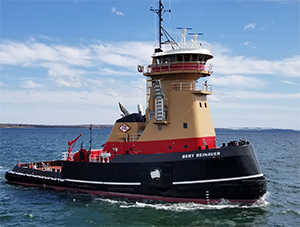Reinauer Transportation didn’t need to look far for its first Tier 4 articulated tug-barge (ATB) design.
Rather than commissioning new plans, the company dusted off drawings from its Nicole-class tugs, the last of which entered service in 2003. Despite their age, the three existing ATBs in the class are strong performers, and their hulls have proved efficient and durable.
These efforts yielded Bert Reinauer, an 8,400-hp SOLAS-rated tug named for the founder of Staten Island-based Reinauer Transportation. The 126-by-40-foot tug is mated with the 523-foot, 160,000-bbl barge RTC 165.
Ocean Tug/Barge Engineering of Milford, Mass., designed the vessels and Reinauer subsidiary Senesco Marine of North Kingstown, R.I., built them. RTC 165, built to haul clean oil products, is reportedly the largest-ever vessel built entirely in Rhode Island.
“We were trying not to reinvent the wheel,” Vice President Chris Reinauer said during a recent vessel tour at Senesco. “We wanted a 150,000- or 160,000-bbl barge, and we had existing units that were successful.”
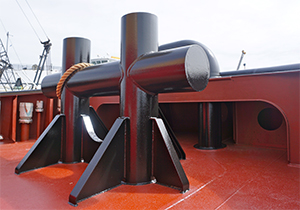 |
|
The sturdy H-bitt installed on Bert Reinauer’s bow. |
|
Casey Conley |
“By building the boats the way we did, we recaptured things like spare parts,” he continued. “The propellers are the same, the shafts are the same, the reduction gears are the same. The only changes that were really big were the engines, the electronics upstairs, the generators and the SOLAS class.”
The lead boat in the class, the 7,200-hp Nicole Leigh Reinauer, entered service in 1999. Christian Reinauer and Meredith C. Reinauer followed in 2001 and 2003, respectively. The vessels are powered by twin Caterpillar 3612 engines and outfitted with Intercontinental couplers.
Propulsion on Bert Reinauer consists of twin GE 12V250 units each generating 4,200 hp at 900 rpm. Reinauer considered several Tier 4 engine platforms, including Caterpillar. GE won out largely because its engines do not require exhaust aftertreatment and related equipment to meet the tougher EPA emissions rules.
“We think on-engine technology is going to be better in the long run,” Reinauer said, referring to the exhaust gas recirculation, or EGR, solution in GE engines. With the other engines, “you give up fuel storage for urea, and you also have an exhaust system that is massive that I am not even sure we could fit in here.”
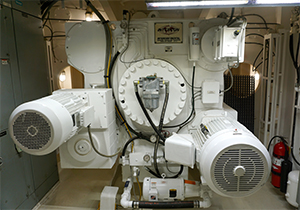 |
|
Bert Reinauer mates with the 523-foot barge RTC 165 through an Intercon 50-inch coupler. |
|
Casey Conley |
GE 12-cylinder engines cool and reroute exhaust gas from one bank of cylinders back into the engine. This reduces the combustion temperature, thus reducing the output of nitrous oxides, or NOx, and other pollutants. Caterpillar and other Tier 4 marine engines on the market inject urea-based diesel exhaust fluid (DEF) into the exhaust stream to reduce emissions.
Naval Architect Robert Hill, president of Ocean Tug/Barge Engineering, developed plans for what he calls the Atlantic II class in the mid-1990s. Unlike the blockier “facet tug” he pioneered for Reinauer more than a decade ago, Bert Reinauer and its siblings have a traditional chined hull form. The three existing Atlantic II ATBs are known as fast, nimble, easy-handling boats with comfortable crew accommodations.
“She has a very, very nice hull under her and nice big wheels with huge rudders,” Hill said of Bert Reinauer in a recent interview. “She steers like a car with the barge, and we put enough power in her that she does well with the barge. She also has very nice accommodations on her.”
The hull has a traditional curved sheer line, and the deckhouses have a rounded design reminiscent of classic tugboats. “Our concession to modernity is the canted pilothouse windows that give the helmsman a no-glare view in all directions for 180 degrees,” Hill said.
RTC 165 is another source of pride. Design characteristics include a water flow-friendly stern that also allows for a large working deck aft. The barge’s bow also has low wave-making characteristics.
“The barge shape, despite what you may naturally think, doesn’t need to look like a containership to go fast,” he said. “We do have barges that look somewhat full-bodied but are very fast. It’s all about where the water goes and how the water flows over the hull.”
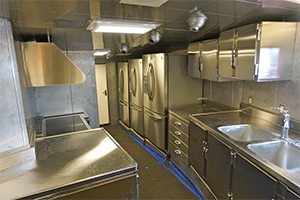 |
|
The easy-to-clean stainless galley is located alongside a comfortable crew mess area. |
|
Casey Conley |
Reinauer uses durable materials and builds redundancy into its boats to avoid repairs and lost time. For instance, all pipes that come through the deck are stainless steel, as are watertight doors and hatch inserts. Installing multiple wash water pumps, water heaters, ballast pumps and other components also prevents a minor malfunction from keeping the tug in port.
The third generator, in addition to the emergency SOLAS unit, is another example. Bert Reinauer’s electrical plant consists of three John Deere 6068 125-kW generators installed side by side in the engine room. A 99-kW John Deere emergency unit required under SOLAS regulations is installed on the main level.
“The first time we have a generator failure and … we sail on time, it pays for the generator,” Reinauer said of the third unit, adding that not all competitors have three gensets on their vessels. “It’s that simple — and we’re not delaying the customer.”
Other than the GE mains, propulsion on the new tug consists of Lufkin reduction gears turning five-bladed Hung Shen props through steel shafts. SOLAS equipment on board includes two Viking life rafts, a Furuno GMDSS in the wheelhouse and a 40-hp rescue boat.
Minor differences between Bert Reinauer and its siblings include extensive use of LED lights on the new tug and the repurposing of a laundry room to add storage space. The washer-dryer units are now located in starboard fiddley.
Bert Reinauer is designed to be comfortable for long voyages between ports. The tug will typically operate with seven people, although it has berthing for 10 in six cabins across three decks. There are four heads, and the bathroom/shower on the main deck has multiple showers and toilets.
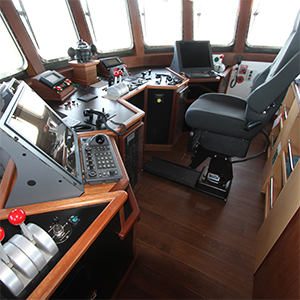 |
|
Bert Reinauer’s pilothouse has a 55-foot height of eye and Furuno electronics. |
|
Chris Reinauer |
The galley located on the 01 deck is equipped with stainless-steel appliances, including three refrigerators. It is separate from the spacious crew mess area. Floating floors are used in crew spaces to reduce vibration and noise. Resilient mount engines also contribute to a quieter environment. The wheelhouse has a 55-foot height of eye and is outfitted with Furuno electronics.
Reinauer long ago decided not to install stern winches on its ATB tugs. The move saves money and recognizes the tugs are unlikely to operate outside the barge’s notch. Over the years, no Reinauer Transportation tug has broken out of the notch while underway, Reinauer said. There is a Coastal Marine Equipment capstan installed aft for line handling in an emergency.
Bert Reinauer mates with the 523-foot RTC 165 using an Intercon 50-inch coupler. The unit has “lightering mode,” meaning the tug can remain in the notch during loading and unloading. Earlier tugs in the class do not have this feature.
Reinauer Transportation operates 25 tug and barge units ranging from 20,000 bbl to 160,000 bbl, primarily along the East Coast. Bert Reinauer will be an expansion of the fleet, and it will carry chemicals and clean oil products anywhere a client needs it to go. Case in point: Another Reinauer ATB, Dylan Cooper and RTC 108, recently traveled more than 2,600 miles from New York to Green Bay, Wis.
Shipbuilders at Senesco should stay busy after Bert Reinauer leaves the yard. Reinauer also is building two smaller Franklin-class facet tugs in the yard. These 116-footers will be paired with existing 80,000- to 100,000-bbl barges.
The vessels, Josephine and Kristy Ann, also will be equipped with GE Tier 4 engines and Nautican propulsion systems. Delivery is expected later this year.

